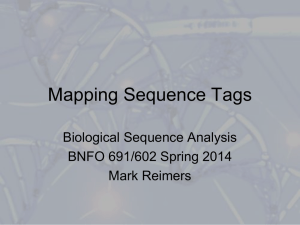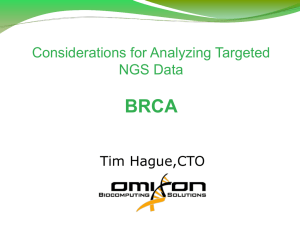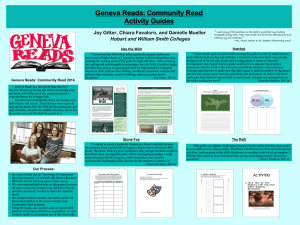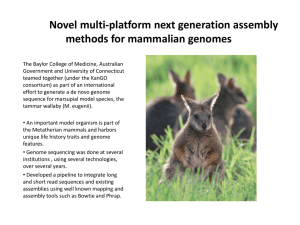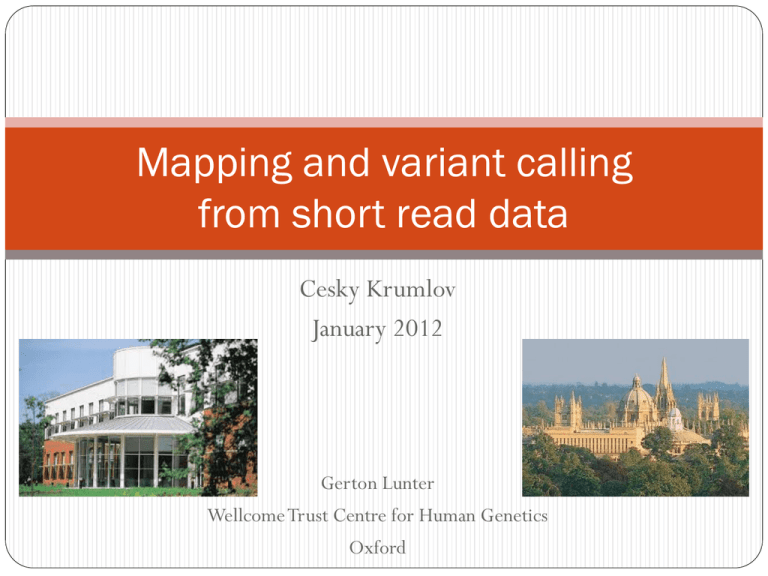
Mapping and variant calling
from short read data
Cesky Krumlov
January 2012
Gerton Lunter
WellcomeTrust Centre for Human Genetics
Oxford
June 26, 2000: “G-Day”
Completion of the Working Draft of the Human Genome
"Let us be in no doubt about what we are witnessing today: A revolution in medical
science whose implications far surpass even the discovery of antibiotics, the first great
technological triumph of the 21st century.” (Tony Blair)
"Having the genetic code is not a very important moment other than it's the
beginning of what we can do with it”. (Craig Venter)
the benefits of human genome mapping will include “a new understanding of genetic
contributions to human disease” and “the development of rational strategies for
minimizing or preventing disease phenotypes altogether.” (Francis Collins)
“it is fair to say that the Human Genome Project has not yet directly affected the
health care of most individuals.” (Francis Collins, more recently)
First human genome:
10 years, ~ $3 billion
Economist June 17 2010
A genome every 2 days
UK£ 3000
Ohtahara Syndrome (Early Infantile Epileptic Encephalopathy)
Trio 1
WGS500 project /
Ed Blair, ORH
De-novo mutations in patients with cortical
malformations
Trio-based whole-exome sequencing
5 putative de novo coding variants.
Manual review: 3 candidates
Two validated, one as mosaic (supported by 4/23 reads)
BRC006
BRC006-F
A.T. Pagnamenta and J.C. Taylor, WTCHG
BRC006-M
March 2011:
15 month old child with severe disease
No diagnosis, no clinical management
Sequencing: mutation found
Suggests therapy, child cured
Why is this a hard problem?
SNPs:
Genome
Exome
Calls
3,591,286
17,085
Mendel errors
169,571
577
Indels:
Genome
Exome
Calls
545,485
286
Mendel errors
166,546
41
Mapping issues (uniqueness)
Alignment issues across splice sites
No stringent filtering of calls
http://www.nature.com/news/2011/110
525/full/473432a.html
Plan for today
Mapping
Sequencing (Illumina)
Mapping
BAM files
Algorithms
Variant calling
Data artefacts
A simple caller: Samtools
Advanced calling: GATK
Allele-based calling: Platypus
Assembly-based calling: Cortex
Afternoon: DIY de-novo disease-causing mutation finding
Illumina sequencing
Illumina sequencing
Illumina sequencing
Illumina sequencing
8 lanes x 2 flowcells
x 48 tiles x 100 bp x 2 reads…
= about 640 Gbase (HiSeq)
~ 210X coverage of the human genome
Sequencing: Paired-end reads
Sequencing both ends helps placement onto genome
Note on orientation:
FIRST read may be the FW or BW read
LEFTMOST mapping read is the FW read, rightmost the BW read
Sequencing: Paired-end reads
Distance between outermost ends is called insert size
DNA insert between the two adapters
Insert size distribution can be controlled at the
library preparation stage
Illumina: max ~ 600, but see later
Sequencing: Coverage
Coverage: average number of times a genomic base is represented
Read coverage: represented in the output as a read base
Physical coverage: represented as an insert (i.e. also counting unsequenced bases)
Contributions to coverage variation:
Statistical (Poisson distribution)
Polymorphisms (large indels, high SNP diversity e.g. in MHC)
Structural variation (seg dups, karyotype abnormalities)
Reference issues (e.g. centromere, telomere)
PCR biases (extremes of GC content usually under-represented)
Sequencing: Coverage
Sequencing – mate pair libraries
Sequencing – mate pair libraries
Stampy has a mode to map mixture of normal (FW/BW) and
mate pair (BW/FW) fragments
Each uses their own insert size distribution
Library complexity, duplicate reads
Some sequences are read several times:
Problem for variant calling
Optical duplicates; secondary seeding
Low amount of starting material
Any (PCR) error will be seen twice: evidence for variant
Post processing: duplicate removal
Standard processing step (e.g. Samtools, Picard)
Not always appropriate: CHiP-seq, mRNA-seq, pooled sequencing
Useful statistic:
(Usage fraction=) α ≈ 2 δ (=duplicate fraction)
α = fragments sequenced / unique fragments in library
δ = fraction of (PCR) duplicates among sequenced reads
Duplicate fraction δ approx additive across lanes (same library)
E.g.: sequencing library on one lane gives 3% duplicate fraction;
sequencing additional lane (same library): ~6% duplicates in combined data
Library complexity, duplicate reads
Assume N unique fragments, usage fraction α
Let r be rate of usage. Then α = 1 – exp(-r) or r = log(1-α)
Number of times a PCR copy is sequenced: Poisson( r )
n=
0
1
2
3
…
Poisson
e-r
r e-r
r2 e-r/2
r3 e-r/6
…
0
1
2
…
Duplicates: 0
Expected number of reads sequenced: N α
N (e-r-1+r)
Expected number of duplicates:
As a fraction of all reads sequenced:
δ
=
(e-r-1+r)/α
=
½α+…
Mapping
Mapping reads
Mapping to a reference:
Often the first step in the processing of HT sequencing data.
Similar to the sequence alignment problem, with some unique features:
reads (query) are short (36 – 150 bp)
reads have relatively many errors (but are annotated with quality scores)
the target can be long (human: 3Gb)
many (easily >billion) reads to process
This has led to the development of “read mappers” :
Focus on “placing” (mapping) the reads, not aligning them
Focus on speed
Examples: BWA, Stampy, ELAND, Novoalign, MAQ, Bowtie, SOAP, …
Mapping reads – fastQ format
Label: identifier & physical position.
/1 = read number (normally 1 or 2)
Read
Qualities
Base qualities: Phred scale
-10 * log10(probability of base error), e.g. “10” = 0.1 “30” = 0.001 etc
Illumina: read often ends in low-quality tail (p~0.7, Q=2, encoded as B or #)
Note: Q score does not encode probability of indel error
Represented as ASCII codes in 2 possible encodings:
Illumina: base-64
(B=2, low quality; h = 40, high quality)
Sanger/BAM: base-33 (#=2, low quality; I = 40, high quality)
Mapping reads: Sensitive to divergence
Can be issue even in human data (e.g. MHC)
72 bp PE
Mapping reads: Paired-end data helps
Increased accessibility of repetitive genome
Increased accessibility (less allele bias) at higher divergence
36 bp
Mapping reads:
Indels can be challenging
insertions
deletions
72 bp PE
Mapping reads is
computationally expensive
HiSeq flowcell ~320 Gb
Mapping reads: anomalous pairs
Large insertions, deletions, and structural variation, may lead
to anomalous read pairs that do not map to the expected
distance of each other
Read mappers vary considerably in their sensitivity for such
read pairs.
BWA often only maps one read of an anomalous pair.
Stampy will keep anomalous pairs as long as each read can be
mapped with sufficient confidence
ELAND treats each read independently
Split reads
This approach allows fragments of a single read to map to
different locations. Works best with long reads (100bp+)
Applications:
large deletions
structural variation (chromosomal translocations, inversions, ..)
mapping across introns for RNAseq data
Tools:
BWASW (part of BWA. Single reads only)
BLAT (Single reads only)
SpliceMap (RNAseq data; single reads only)
RNAseq mapping
RNASeq is a widely-used protocol for analyzing the
transcriptome, with advantages over microarrays:
Unbiased assessment of expression (no probes)
Better dynamic range
Can assess expression of alternatively spliced transcripts
Discovery of transcript and splice junctions
Protocols available for miRNAs, ncRNAs, non-polyA RNAs, …
Mapping RNAseq data is challenging:
To genome: good fraction of inserts/reads spans splice junction.
Mapper that can deal with large insertions / partially mapping reads helps
To transcriptome: no discovery; high degree of repetitiveness
RNAseq mapping
TopHat:
Maps (fragments of) reads to genome, builds splice junctions
Built on top of Bowtie
very fast, not very sensitive
SpliceMap
Maps 25bp fragments to genome, builds splice junctions
Uses Bowtie
There are currently no mappers that integrate splice-awareness
into the mapping algorithm.
BAM files
BAM files
Standard file format to report mapped reads
Capillary, Illumina, SOLiD, 454, PacBio, IonTorrent, Nanopore, …
Extensible
Mix of obligatory and optional data fields
Flexible: many read types
single, paired-end, fragmented, unmapped, mix of libraries/platforms
Holds meta information
Binary compressed file format
Indexable
ASCII version of format (SAM) defined (samtools.sourceforge.net/SAM1.pdf)
Developed by the 1000 Genomes Project consortium
BAM (actually: SAM) files
BAM files
Header
Reads
BAM files
Header line:
version; sort order
BAM files
Reference definition
One for each chromosome/contig
BAM files
Read groups:
smallest physical grouping of
reads (e.g. lane, multiplex)
BAM files
Identifier: Unique to fragment
1st/2nd read have same identifier
BAM files
Bit-wise flag:
147=1+2+16+128
Bit-wise flag:
99=1+2+32+64
1: multiple fragments (e.g. read pairs)
16: sequence was rev complemented
2: all fragments “properly” aligned
32: next fragment’s sequence was rc’ed
4: fragment unmapped
64: first fragment
8: next (=other) fragment unmapped
128: last fragment
BAM files
Chromosome read
was mapped to
BAM files
Position read was
mapped to
BAM files
Mapping quality
Mapping quality = posterior probability that
mapping position is wrong
Expressed as Phred score (-10 log10 p):
“0”: p = 1.0 : almost certainly wrong
“3”: p=0.5 : one other equally likely position found
“10”: p = 0.1
“30”: p = 0.001 etc.
BAM files
Alignment
Alignments are expressed as a “CIGAR”
(Compact Idiosyncratic Gapped Alignment Report)
string
M = match (bases may be different), I = insert, D = delete
S = soft clip (“insert” at either end of sequence deemed not to represent true bases)
BAM files
Chromosome and
position of mate
BAM files
Inferred insert size
BAM files
Sequence
Sequence as it came off the machine
Reverse-complemented if mapped to the BW reference strand (flag: bit value 16)
BAM files
Qualities
Sequence as it came off the machine
Reversed if mapped to the BW reference strand (flag: bit value 16)
Encoding: Phred base 33 (# = 2)
BAM files
Optional additional
information
Many fields have a defined meaning (e.g. NM: number or mismatches; RG: read group)
Controlled type (:i: = integer; :Z: = string, etc)
Tags starting with X, Y, Z are undefined: free for application-specific uses
Bam files - tools
Processing
Samtools
SAM<->BAM
sorting, indexing, merging, duplicate removal
Remote retrieval (FTP or HTTP) of BAM file fragment
Picard
merging, duplicate removal
Viewing
Samtools view (SAM)
Samtools tview (ASCII browser)
IGV (Java graphical browser)
Algorithms
Algorithms
read mappers have similar aims to good-old BLASTn:
search and align a nucleotide query to a nucleotide database
Unique features:
Very many queries (~109)
Queries are short (~36 – ~150 bp)
Reference can be long
Queries usually not very divergent from reference (0.1 - few %)
Queries can have substantial numbers of base errors
Reads come in pairs and have base qualities
Approach 1: Hashing reads
Process reads in batches: keeps hash table small
Naïve hashing of whole genome requires:
4 bytes per entry, times
3*10^9 entries, divided by
fill factor ~0.7 (less for repetitive data): 17 Gb: too much
Advantage
Hashing allows for high sensitivity
Drawback: entire genome is scanned for each batch
MAQ: genome is scanned 3 times per batch
Slow, particularly for small number of reads
Approach 1: Hashing reads
Examples: ELAND, MAQ
n=9
keys
h(r1)
read 1
h(r2)
read 2
read 3
read 4
h(r3) h(r4)
h(r4)+1
read 5
h(r5)
m=5
Fill factor α=m/n
Approach 1: Hashing reads
scan genome
subsequence (12 nt)
6 patterns (MAQ)
hash table (x6)
candidate
reads
Approach 2: Burrows-Wheeler transform
Response to speed / memory issues of 1st approach
BWT:
Compressed index
Very efficient at storing (and retrieving) repetitive sequence
Advantages
Good memory usage, very fast
Disadvantages
Not best suited for inexact matches lower sensitivity than hash-
based approaches
The Burrows-Wheeler transform (1994; 1983)
c a c a a c g $
c
a
c
a
a
c
g
$
a
c
a
a
c
g
$
c
c
a
a
c
g
$
c
a
a
a
c
g
$
c
a
c
a
c
g
$
c
a
c
a
c
g
$
c
a
c
a
a
g
$
c
a
c
a
a
c
$
c
a
c
a
a
c
g
$
a
a
a
c
c
c
g
c
a
c
c
a
a
g
$
a
c
a
g
a
c
$
c
c
g
a
$
c
a
c
a
a
$
c
c
g
a
a
c
a
c
g
a
$
c
c
a
c
a
$
c
c
g
a
a
g
c
c
a
a
$
a
c
g c c a a $ a c
BWT is reversible
$
a
a
a
c
c
c
g
g c c a a $ a c
c
a
c
c
a
a
g
$
a
c
a
g
a
c
$
c
c
g
a
$
c
a
c
a
a
$
c
c
g
a
a
c
a
c
g
a
$
c
c
a
c
a
$
c
c
g
a
a
g
c
c
a
a
$
a
c
$ a a a c c c g
BWT is reversible
$
a
a
a
c
c
c
g
g$ ca ca aa ac $c ac cg
c
a
c
c
a
a
g
$
a
c
a
g
a
c
$
c
c
g
a
$
c
a
c
a
a
$
c
c
g
a
a
c
a
c
g
a
$
c
c
a
c
a
$
c
c
g
a
a
g
c
c
a
a
$
a
c
$c aa ac ac ca ca cg g$
BWT is reversible
$
a
a
a
c
c
c
g
c
a
c
c
a
a
g
$
a
c
a
g
a
c
$
c
c
g
a
$
c
a
c
a
a
$
c
c
g
a
a
c
a
c
g
a
$
c
c
a
c
a
$
c
c
g
a
a
g
c
c
a
a
$
a
c
Relation with Suffix Arrays / Trees
• Suffix array (Gene Myers, Udi Manber,1991):
Array of start positions of lexicographically sorted set of suffixes
c a c a a c g
a
a
a
c
c
c
g
a
c
c
a
a
g
c
a
g
a
c
g
a c g
c g
a a c g
SA:
[4, 2, 5, 3, 1, 6, 7]
BWT:
Set of substring prefixes occupy contiguous segment in SA
SAs are similar to Suffix Trees (1973), but more efficient and less powerful.
Suffix Trees take ~20N bytes for input of size N (“good implementations”)
SAs take 4N bytes
BWT take N bytes, and can be compressed
$
a
a
a
c
c
c
g
c
a
c
c
a
a
g
$
a
c
a
g
a
c
$
c
c
g
a
$
c
a
c
a
a
$
c
c
g
a
a
c
a
c
g
a
$
c
c
a
c
a
$
c
c
g
a
a
g
c
c
a
a
$
a
c
FM index (Ferragina and Manzini, 2000)
Two tables:
A: Compressed version of BWT
B: Table of starting positions of a subset of suffixes
Two algorithms (~ the two stages in the BWA mapping process):
I: Lookup the index k (or range k…l) in the BWT table for a substring
II: Compute the starting position(s) in the reference of suffix BWT[k]...BWT[l]
Algorithm I uses table A, takes O(1) time
Algorithm II uses table B, and takes O(log2 N ) time (N = genome size)
Together, the number and location of substrings of length p can be found in
O( p + number-of-occurrences * log2 N ) time.
Read mappers implementing BWT
BWA
Fast, accurate, fairly sensitive, popular (eg. 1000G project)
Provides mapping qualities
Does not use base qualities
Bowtie
Very fast; not very sensitive; mostly for mRNA-seq data
No mapping qualities
Does not use base qualities
Soap2
No experience
Approach 3: Fast hashing
Stampy
Advantages:
Sensitive
SNPs + indels, better than BWA, ELAND, MAQ; similar to Novoalign
Good memory footprint (similar to BWA, MAQ, ELAND)
Disadvantage
Slower than BWA
Approach 3: Fast hashing
n=9
keys
• Successful search:
time ~ O[ log (1-α) / α ]
Logarithmic growth as α1:
Fast
a
b
d
c
• Unsuccessful search:
time ~ O[ 1 / (1-α) ]
Hyperbolic growth as α1:
Slow
e
m=5
Fill factor α=m/n
In practice, need to keep α<0.7
Approach 3: Fast hashing
Modern fast hashing algorithms not applicable
Cuckoo hashing, Robin Hood hashing
Only hash unique objects (i.e. don’t implement multimap / multiset)
Idea: mark last object in chain, for early termination of search
Requires new data structure and hash algorithm
Result:
Successful and unsuccessful searches in logarithmic time
Fill factors of 0.98 possible, still faster than standard hash table with α=0.7
Deletion is easy to implement (not possible in standard hash table)
Stampy – first part of algorithm
scan read
15 bp subsequence;
0 or 1 mismatch
29 bit word
4 bytes x
229 entry (2 Gb)
hash table
Remove
rev-comp
symmetry
candidate
positions
Stampy – second part of algorithm
Banded alignment
(max 15 bp indels)
Genome
Standard algorithm, special
implementation
Using x86 vector instructions:
• Linear-time
• Dynamic Programming table
in registers
Read
Part 2: Variant calling
Variant calling
Aim: produce variant calls (w.r.t. reference), and genotype calls
True variants usually easy to spot
But: SNPs easier than indels easier than SVs
And: Sufficient coverage required
Divergence / diversity often low (human: 0.1%)
False positives are an issue
Content:
Some examples
Data issues
indel errors
Three callers: Samtools, GATK, Platypus
4 reads:
1 bp insertion
5 reads:
1 bp deletion
4 reads:
reference
Data issues
Primary data
PCR errors (base errors)
SOLiD: reference bias (reference-based color decoding)
Base quality calibration
Indel errors
Overlaps
Duplicates
Primers
Alignment
Base-level misalignments around indels
Reference / mapping
Unrepresented seg dups
Repetitive sequence
Data issues
Primary data
PCR errors (base errors)
SOLiD: reference bias (reference-based color decoding)
Base quality calibration
Indel errors
Overlaps
Duplicates
Primers
Alignment
Base-level misalignments around indels
Reference / mapping
Unrepresented seg dups
Repetitive sequence
Site frequency spectra – indels in homopolymer runs
…TTTCGTACGTGAAAAAACCTGTGCGAAGTG… : homopolymer run 6
Method 1 (TRIO):
Non-Mendelian alleles in trios
Mother:
Father:
20 x ref
2 x +A
12 x ref
12 x -AA
Child:
14 x ref
3 x +A
1 x +AAA
Choose parsimonious child alleles from mother and father:
- explain largest number of reads in M+F+C
- alleles supported by >= 2 reads in each of M,C / each of F,C
Remaining child alleles classified as errors
Method 2+3 (DISTRIB, high/low coverage resp.):
Modeling the allele count distribution
1000000
Observed
100000
Hom
ref (Nhr)
Inferred heterozygotes
10000
Hom
alt (Nha)
Hets (Nh)
1000
Errors (ε)
100
0
1
2
3
4
Non-ref allele count
Allele bias (β)
5
6
Indel errors occur in repeat tracts
Higher error rates
(phred scale)
repeat unit
Longer repeat tracts
All 3 methods give
similar results
Homopolymers
Tandems (unit 2)
OTH.TRIO
OTH.DISTRIB.C6
OTH.DISTRIB.C15
Tandems (unit 3)
Tandems (unit 4)
Sequence
composition
matters
OTH. TRIO
Tandem repeats
composed of longer units
are also prone to errors
OTH. TRIO
OTH.DISTRIB.C15
OTH.DISTRIB.C6
Variant callers
Samtools
Uses “pileup”: column-by-column approach
Uses “BAQ” (base alignment quality) to suppress spurious
SNPs due to unrecognized indels
Advantages:
Fast, simple to use
Good for low coverage data
Disadvantages
Can have high FP rate for
high coverage data
Not very good for indels
The topology of the profile HMM for BAQ computation.
Li H Bioinformatics 2011;27:1157-1158
© The Author 2011. Published by Oxford University Press. All rights reserved. For Permissions,
please email: journals.permissions@oup.com
Transition–transversion ratio (ts/tv) as a function of the number of SNP calls.
Li H Bioinformatics 2011;27:1157-1158
© The Author 2011. Published by Oxford University Press. All rights reserved. For Permissions,
please email: journals.permissions@oup.com
GATK
“Genome Analysis ToolKit” – Broad institute
Features:
Base quality recalibration
Re-alignment around known indels
BAQ
VQSR (variant quality-score recalibration)
Advantages:
High quality SNP calls (in combination with BWA, not Stampy)
Disadvantages:
Difficult to use
Slow
Requires high-quality SNP set for training, known indels for re-alignment
Indel call quality currently not great
VQSR
Builds empirical model to classify calls in true and false
Can combine many (interdependent) covariates
Requires training set of trusted calls
Platypus
Haplotype-based approach
Windowed, rather than column-by-column
Integrated SNP and indel calling
Accounts for actual (LD) and technical (alignment) interaction between variants
3-step process: candidate generation; haplotype alignment; calling
Can use candidates from different sources (e.g. known set, local assembly, read alignm’t)
Haplotype alignment allows detailed error modeling
Advantages
Good SNP calls, better indel calls
No need for indel realignment, BAQ
Fast
Disadvantages
Not yet published…
Integrated SNP and indel calling
Indels are often mis-called as SNPs.
Example:
chr20:257160 A T;
chr20:257162 T C
Platypus: chr20:257157: +TCTTTCTTTT
1000G:
Reference:
1000G SNPs:
Platypus insertion:
CTTGCGCTCTATTTTT
CTTGCGCTCTTTCTTT
CTTGCGCTCTTTCTTTTCTATTTTT
Platypus
Candidate
variants
+AT
-AAAT
C/T
Haplotypes
…GTCAAATCCT…
…GTCAAATTACCT…
…GTC[-]CCT…
…GTC[-]TACCT…
…GTTAAATCCT…
…GTTAAATTACCT…
…GTT[-]CCT…
…GTT[-]TACCT…
…GTCAAAT--CCT…
TTAAATTACC
Variant and
genotype calls
…GTCAAATTACCT…
TTAAATTACC
…GTTAAATTACCT…
TTAAATTACC
Frequencies
……
Read
alignments
Samtools:
25103279:
25103291:
25103294:
25103296:
25103301:
21 bp deletion
9 bp deletion
6 bp deletion
AG
6 bp insertion
Platypus:
25103279: 21 bp deletion
Cortex
Assembly-based caller
Analyzes the topology of the de Bruijn graph to call variants
Can use reference to improve sensitivity (hom alt calls)
Advantages:
Works for a range of variants, including large SVs
Works in highly divergent regions (e.g. human MHC)
No reference required (but is useful)
Disadvantages
Sensitivity for SNPs, small indels lower than mapping-based approaches
Only works in unique regions
Requires high coverage (30X or more)
In press (Z. Iqbal et al., Nature Genetics)
Analyzing the de Bruijn graph
Up to 80% power to detect variants
Good sensitivity for larger indels
Structural variation
Larger deletions (>50 bp), larger insertions (TEs), segmental
duplications, copy number variations (CNVs), complex events (eg.
insertion+deletion), translocations, inversions
Difficult
Rare events; false positives are a real problem
Some tools
GenomeSTRiP: good for large deletion calls
Pindel: medium-sized insertions and deletions
BreakDancer: wide range of variants. High FP rate.
Cortex: (not much experience yet)
Variant calling – best practice I
Coverage
Single samples: aim for average 25X or more
avg 8X is borderline sufficient if you’re looking for homozygous variants
Multiple samples from same population/family/organism:
Less is possible (e.g. 1000G, avg 4X per individual)
Very low coverage:
call sites;
compute genotype likelihoods;
use Beage/Impute/etc. to leverage LD for genotype calls
Exon capture
Check average on-target coverage (as opposed to total mapped reads)
Large variation: Aim for 25X minimum coverage at large fraction of target.
Rule of thumb: 150X average (6 times 25X)
PCR amplicons
Shearing of short fragments inefficient uneven coverage
Differential efficiency for different amplicons
Potential for allele bias if primer overlaps unknown variant
Variant calling – best practice II
If possible, call multiple sample simultaneously (High cov data: Not necessary but may still help)
Families, tumor/normal, population
Reduces FP rate; can improve genotype calls
Creating your BAM file
Remove duplicates (in data merged across libraries or samples)
Use most complete reference available to map to
include unplaced / badly assembled contigs
(With GATK / Samtools:) Consider re-alignment around indels (expensive!)
Use filtering
PCR errors: allele bias
Reference issues, seg dups: anomalous coverage
Primers/adapters; mapping issues: strand bias
If appropriate:
Restrict to non-synonymous coding variants; remove common variants (dbSNP, 1000G, …), remove variants seen
multiple times in your pipeline (removes systematic errors)
Check quality of calls
ti/tv (Human: ~2.3; higher in exons; FPs tend to have ti/tv of 0.5)
triplet / non-triplet ratio in coding exons
higher is better, but beware of strange bias in Samtools
look at raw number of calls, to sanity check
Lunch!



